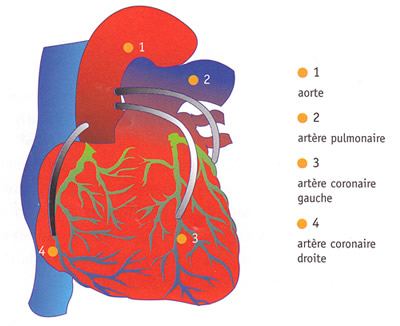aorto-coronary bypass
What is coronary artery bypass grafting?
The coronary bypass surgery is a surgical procedure which consists of:
Either in the implantation of a vein between the aorta and the part of the vessel located downstream of the lesions. This venous conduit is usually taken from the leg and bypasses the atherosclerotic stricture.
Either placing and suturing an accessory artery, the internal mammary artery, on the part of the anterior interventricular or the right coronary, located downstream of the lesions.
What is a coronary artherosclerotic lesion?
 Coronary artery bypass surgery is a surgical treatment for atherosclerotic coronary lesions responsible for angina pectoris or myocardial infarction.
Coronary artery bypass surgery is a surgical treatment for atherosclerotic coronary lesions responsible for angina pectoris or myocardial infarction.
The coronary arteries are the two arteries that surround the heart and supply blood to the heart muscle. These two arteries arise from the initial part of the aorta. Atherosclerosis is characterized by a deposit of fat and fibers inside this artery leading to a narrowing of its caliber, or even to the complete obstruction of it. A blocked coronary artery reduces blood flow to the heart muscle. When blood flow is reduced, it can result in angina pain or even myocardial infarction.
What is the purpose of coronary artery bypass grafting?
The goal of coronary artery bypass grafting is to restore adequate blood flow to the heart muscle . If the blood flow becomes satisfactory again, this means the disappearance or very noticeable reduction of angina pectoris, the reduction of medical prescriptions, the improvement of physical performance. The operation can also extend the service life.
Duration of the intervention
In general, this operation lasts from 3 to 6 hours; however the duration of the operation depends on the complexity of the heart condition. As a result, each operation is different and the duration can be difficult to predict from patient to patient.
What happens immediately after the procedure?
Once the operation is complete, patients are cared for for 24-72 hours in a intensive care unit; this is where the patient regains consciousness after the effects of the anesthesia have worn off.
What incisions are made?
The incisions used to reach the heart are made along the middle part of the anterior surface of the chest through the sternum. There are also one or more incisions in the legs to remove the veins that will be used for coronary artery bypass grafting. Occasionally there may also be an incision in the groin.
Resuscitation
Deep breathing and coughing exercises are extremely important for fast recovery. The nurse or physiotherapist can help you with these breathing maneuvers. Many patients fearing the existence of pain or discomfort do not want to make these coughing efforts, but it is essential that they are nevertheless made.
Post-operative
The degree of activity is prescribed individually for each patient. At first, he can sit or walk around the room. Later, we will plan a short period in the hallway and possibly the climb of a few stairs.
Healing of incisions
Immediately after the operation, the chest is exposed to the air. The number and length of incisions in the legs vary from patient to patient, depending on how many grafted veins the surgeon has had to remove. A few patients have a single incision on one leg while others have multiple incisions on both legs. About 4 to 5 weeks are necessary to obtain the complete healing of these scars. The color of the wound will gradually change from purple to pinkish red, then returning to normal coloration after several months.
Duration of hospitalization
Usually the hospital stay is 10-15 days. During this period and beyond, some patients may have sometimes "good" days, sometimes "bad" days with a progressive improvement.
Regime
The doctor or a dietitian will explain how to change your diet plan. Of course, it is prudent to reduce the risk factors for atherosclerotic lesions by reducing salt, saturated fat intake and sugar consumption. It is also important to have a normal weight and reduce possible obesity.
Medical Surveillance
There are three periods to be distinguished:
One to two months after the surgery, the medical-surgical team will carry out a new visit to way to check the quality of the scars and to take stock to detect early cardiac abnormalities.
The rest of your medical supervision will be carried out by your attending physician and by your cardiologist.
After your surgery, a full check-up is often necessary. This assessment may include a stress test and possibly a coronary angiography to check the patency of the corollary bypass(es), and the quality of the result of the revascularization obtained.
Gender after the intervention
Aorto-coronary bypass surgery is performed to make your life as normal as possible, to remove the pain, (i.e. angina pectoris), to avoid more severe accidents and possibly prolong life. Your doctor and your cardiologist can advise you on resuming your professional activity and continuing the treatment. However, it should be emphasized that the coronary artery bypass bypassed an atherosclerotic lesion but did not eliminate the cause of the disease: it is therefore important to prevent it from recurring or accelerating. , taking great care to eliminate the risk factors as completely as possible.
Completely and permanently quit smoking, control blood pressure, control the level of fats in the blood (cholesterol, triglycerides), possibly treat diabetes, return to a substantially normal weight.